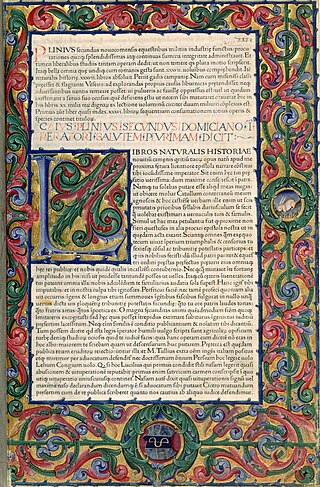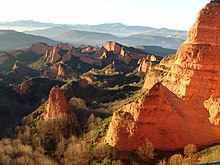
Gaius Plinius Secundus, called Pliny the Elder, was a Roman author, naturalist, natural philosopher, and naval and army commander of the early Roman Empire, and a friend of the emperor Vespasian. He wrote the encyclopedic Naturalis Historia, which became an editorial model for encyclopedias. He spent most of his spare time studying, writing, and investigating natural and geographic phenomena in the field.

The Natural History is a Latin work by Pliny the Elder. The largest single work to have survived from the Roman Empire to the modern day, the Natural History compiles information gleaned from other ancient authors. Despite the work's title, its subject area is not limited to what is today understood by natural history; Pliny himself defines his scope as "the natural world, or life". It is encyclopedic in scope, but its structure is not like that of a modern encyclopedia. It is the only work by Pliny to have survived, and the last that he published. He published the first 10 books in AD 77, but had not made a final revision of the remainder at the time of his death during the AD 79 eruption of Vesuvius. The rest was published posthumously by Pliny's nephew, Pliny the Younger.

The palm is an obsolete anthropic unit of length, originally based on the width of the human palm and then variously standardized. The same name is also used for a second, rather larger unit based on the length of the human hand.
Gaetuli was the Romanised name of an ancient Berber tribe inhabiting Getulia. The latter district covered the large desert region south of the Atlas Mountains, bordering the Sahara. Other documents place Gaetulia in pre-Roman times along the Mediterranean coasts of what is now Algeria and Tunisia, and north of the Atlas. During the Roman period, according to Pliny the Elder, the Autololes Gaetuli established themselves south of the province of Mauretania Tingitana, in modern-day Morocco. The name of the Godala people is hypothesized to be derived from the word Gaetuli.

Abu al-Qasim Abbas ibn Firnas ibn Wirdas al-Takurini, also known as Abbas ibn Firnas was an Andalusi polymath: an inventor, astronomer, physician, chemist, engineer, Andalusi musician, and Arabic-language poet. He was reported to have experimented with unpowered flight.

The Frisii were an ancient Germanic tribe with Celtic cultural elements living in the low-lying region between the Rhine–Meuse–Scheldt delta and the River Ems.

Las Médulas is a historic gold-mining site near the town of Ponferrada in the comarca of El Bierzo. It was the most important gold mine, as well as the largest open-pit gold mine in the entire Roman Empire. Las Médulas Cultural Landscape is listed by UNESCO as a World Heritage Site. Advanced aerial surveys conducted in 2014 using LIDAR have confirmed the wide extent of the Roman-era works.

The groma was a surveying instrument used in the Roman Empire. The groma allowed projecting right angles and straight lines and thus enabling the centuriation. It is the only Roman surveying tool with examples that made it through to the present day.
The technology history of the Roman military covers the development of and application of technologies for use in the armies and navies of Rome from the Roman Republic to the fall of the Western Roman Empire. The rise of Hellenism and the Roman Republic are generally seen as signalling the end of the Iron Age in the Mediterranean. Roman iron-working was enhanced by a process known as carburization. The Romans used the better properties in their armaments, and the 1,300 years of Roman military technology saw radical changes. The Roman armies of the early empire were much better equipped than early republican armies. Metals used for arms and armor primarily included iron, bronze, and brass. For construction, the army used wood, earth, and stone. The later use of concrete in architecture was widely mirrored in Roman military technology, especially in the application of a military workforce to civilian construction projects.

The Canal of the Pharaohs, also called the Ancient Suez Canal or Necho's Canal, is the forerunner of the Suez Canal, constructed in ancient times and kept in use, with intermissions, until being closed in 767 AD for strategic reasons during a rebellion. It followed a different course from its modern counterpart, by linking the Nile to the Red Sea via the Wadi Tumilat. Work began under the pharaohs. According to Darius the Great's Suez Inscriptions and Herodotus, the first opening of the canal was under Persian king Darius the Great, but later ancient authors like Aristotle, Strabo, and Pliny the Elder claim that he failed to complete the work. Another possibility is that it was finished in the Ptolemaic period under Ptolemy II, when engineers solved the problem of overcoming the difference in height through canal locks.

Ceterum (autem) censeo Carthaginem esse delendam, often abbreviated to Carthago delenda est or delenda est Carthago, is a Latin oratorical phrase pronounced by Cato the Elder, a politician of the Roman Republic. The phrase originates from debates held in the Roman Senate prior to the Third Punic War between Rome and Carthage. Cato is said to have used the phrase as the conclusion to all his speeches, to push for the war.

Roman technology is the collection of antiques, skills, methods, processes, and engineering practices which supported Roman civilization and made possible the expansion of the economy and military of ancient Rome.
Metals and metal working had been known to the people of modern Italy since the Bronze Age. By 53 BC, Rome had expanded to control an immense expanse of the Mediterranean. This included Italy and its islands, Spain, Macedonia, Africa, Asia Minor, Syria and Greece; by the end of the Emperor Trajan's reign, the Roman Empire had grown further to encompass parts of Britain, Egypt, all of modern Germany west of the Rhine, Dacia, Noricum, Judea, Armenia, Illyria, and Thrace. As the empire grew, so did its need for metals.

A votive crown is a votive offering in the form of a crown, normally in precious metals and often adorned with jewels. Especially in the Early Middle Ages, they are of a special form, designed to be suspended by chains at an altar, shrine or image. Later examples are more often typical crowns in the style of the period, either designed to be placed on the head of a statue, or re-used in this way after donation.
Aspergillus flavescens is a rare species of fungus in the genus Aspergillus. Aspergillus flavescens can cause Myringomycosis.

Earth's circumference is the distance around Earth. Measured around the equator, it is 40,075.017 km (24,901.461 mi). Measured passing through the poles, the circumference is 40,007.863 km (24,859.734 mi).

A chaplet is a headdress in the form of a wreath made of leaves, flowers or twigs woven into a ring. It is typically worn in festive occasions and on holy days. In ancient times it also served as a crown representing victory or authority.
Artace or Artake was a town of ancient Mysia, near Cyzicus. It was a Milesian colony. It was a seaport, and on the same peninsula on which Cyzicus stood, and about 40 stadia from it. in Greek mythology, Artace is mentioned as the place where the argonauts changed the stone anchor of the Argo for a larger one. Artace was burnt, together with Proconnesus, during the Ionian Revolt, in the reign of Darius I. Probably it was not rebuilt for quite some time, for Strabo in the 1st century does not mention it among the Mysian towns: but he speaks of a wooded mountain of the name, with an island of the same name near to it, the same which Pliny the Elder calls Artacaeum. Timosthenes, quoted by Stephanus of Byzantium, also gives the name Artace or Artake to a mountain, and to a small island, one stadium from the land. In the time of Procopius, Artace had been rebuilt, and was a suburb of Cyzicus.
Drugs in ancient Rome were used for a variety of purposes. Cannabis and opium were used as medication to treat conditions such as insomnia or earaches. Roman doctors noticed the addictiveness of these drugs. They wrote that cannabis induced "a warm feeling" and opium was dangerous when diluted. Alcohol was believed to be beneficial when consumed in moderate amounts, yet harmful when consumed in excess. Ancient Roman authors and philosophers, such as Pliny and Seneca, believed that alcohol could cause problems such as frenzy, criminality, tiredness, hypersexuality, decreased sexual potency, and death, and that it would damage the social order.
Modern historians' knowledge of ancient Roman gynecology and obstetrics primarily comes from Soranus of Ephesus' four-volume treatise on gynecology. His writings covered medical conditions such as uterine prolapse and cancer and treatments involving materials such as herbs and tools such as pessaries. Ancient Roman doctors believed that menstruation was designed to rid the female body of excess fluids. They believed that menstrual blood had special powers. Roman doctors may also have noticed conditions such as premenstrual syndrome.













